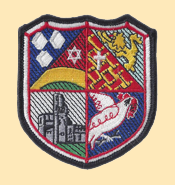
Christlieb-Chrislip-Crislip Family Association
Portions of the text that follows, are from the Christlieb-Chrislip-Crislip Family Association-sponsored history and genealogy publication, Ancestors and Descendants of Friedrich Carl and Anna Catharina Christlieb.
Friedrich Carl Christlieb — His Story
Although only scant information survives pertaining to the life of Friedrich Carl Christlieb, one can, nevertheless, get a sense of his persona by examining historical records and by reflecting on oral tradition, as reported by the first two generations of his family in America.
When comparing theirs with other family genealogies, it does not take long for descendants of Friedrich Carl Christlieb to realize that their genealogy is quite unique. It is a rare thing that any family would know, almost to the hour of a particular day in history, when their family began.
Friedrich Carl Christlieb was a Jew by birth. At the time of his conversion to Christianity (Lutheran) in 1742, he was a resident of Frankenstein, a small but significant community located in the Eisenach Valley, along a trade route between France and the German Palatinate.
Prior to his conversion, Friedrich Carl’s name was Simon. It is not known if Simon was his first name or his surname. In that part of Germany, and at that period of time, some Jews had surnames, but many did not. Before his conversion and for purposes of reference, Friedrich Carl is referred to as Simon aus Frankenstein.
It deserves to be mentioned that census records of Frankenstein show a Jewish adult male, by the name of Jacob, as head of a household. Being contemporaneous with Simon’s residence there, there is some plausibility that this man could have been Simon’s father. That this could be possible rests with the age-old tradition of naming one’s first-born son after the paternal grandparent. If indeed Simon’s father’s name was Jacob, Simon would have been called Simon ben Jacob, particularly, if he did not have a surname. However, there is no hard evidence to support this supposition.
Aside from these few facts, nothing further is known about the ancestry of this patriarch of the American Christlieb-Chrislip-Crislip family.
Simon aus Frankenstein
Other than his name and some dates and places where he resided, very little is known of the man who became Friedrich Carl Christlieb. The Dürkheim Chronicles makes reference to various Jews at the time and most have surnames. As mentioned earlier, nothing has been found to indicate if Simon was his first name or his surname. “Simon aus Frankenstein,” defines him as having been from the village of Frankenstein.
On May 17, 1742, a letter was sent by the Lutheran Church at Dürkheim to Count Christian Carl Reinhard of Leiningen, requesting the Count’s presence at the conversion/baptism of “a young bachelor from Frankenstein who came seeking instruction in the Christian religion. ” The Dürkheim church register shows that Count Christian Carl Reinhard was not only present as God-Sponsor for the new convert, his entire household – The House of Heddesheim – witnessed the occasion, along with other luminaries including the Elector of the Palatinate and the household of Count Friedrich Magnus, whose capital was at Dürkheim.
Anna Catharina’s husband, Gottfried Bock, died just two months before Friedrich Carl’s conversion, on the 17th of February. It would seem at first glance that Simon’s motive for conversion would have been his desire to marry a Christian girl; however, the letter signed by the Pastor and the Superintendent says that Simon had come to them near the end of the previous year seeking instruction; perhaps in late December. One does wonder whether these men of the church may have been somewhat less than ingenuous about the actual length of Simon’s instructional time, in order to hasten the acceptability of the marriage.
It is believed that Simon and Gottfried Bock were acquainted with one another, as there is evidence that both were employed at the salt distillery, which was located at the outskirts of Dürkheim at Schöfeld. Memories of the saltworks, which had been preserved in the Christlieb family’s oral tradition, were included in Benjamin Franklin Christlieb’s 1895 history of the family.
The Salt Distillery at Dürkheim
As far back as the 12th century, salt had been extracted from the numerous salt springs in the area. One of the most productive was near the Cloister at Schönfeld. After the monastery was dissolved, Elector Friedrich IV, built a saltworks on the spot in 1595; however, all had fallen apart by the end of the Thirty-Years’ War. In 1716, a new salt refinery was constructed on the ancient site. The refinery at Schönfeld reportedly took five water wheels to drive the pumps that brought the brine out of the spring and into the six refineries. Known as Philippshall, i.e. Phillip’s Salt, the saltworks was named for Prince Karl Philipp III, Elector of the Lower Palatinate.
At some point in the early 18th century, the management of the salt distillery was handed over to the Baron of Beust from Saxony, who carried the distinguished title, “Lord Privy Chamberlain von Beusten.” Baron von Beusten was a witness at the baptism of Gottfried and Anna Catharina’s daughter, Johanna Susanna Elizabetha Bock. His distinguished presence is a positive indication that Gottfried Bock’s position at the refinery was well respected.
Baron von Beusten was also present at Simon aus Frankenstein’s conversion to Christianity. In Friedrich Carl’s baptismal entry he is referred to as “The Royal Danish and Electoral Palatine Privy Councilor and Baronial Excellency, the Salt-Distillery Director.” The presence of Baron von Beusten adds credence to the belief that Simon was also employed at the saltworks.
It is known that at the time of Friedrich Carl’s conversion, the salt distillery was fully operational and profitable. To ensure these profits, an order was issued declaring Dürkheimer salt as the national salt. Its quality was said to be superior to all other salt in Germany and better than salt imported from Holland. All officials and subordinates were obligated to order salt only from the Dürkheim salt distillery. Any transgressions to this decree met with harsh penalties. In 1724, the Palatine levied a salt tax that brought in 32,000 Gulden annually. Salt could only be ordered by vendors commissioned from Dürkheim, and all sales had to be registered in salt books. Salt auditors saw to it that everything was handled properly. Refining the precious commodity was carried out in a specific fashion, requiring an evaporation process that took thirteen days to complete. The process also required a tremendous amount of firewood. It was recorded that, in 1742, the saltworks management made a wood supply contract with the city in which 50,000 cords of wood could be cut from the Limburg-Dürkheim forest.
Employment at the saltworks may have figured into Simon’s conversion to Christianity, as it was obviously the most desirable place to work in the community. If Friedrich Carl was indeed the independent character he is reported to have been, his ambition may have driven him to change his religion in order to be employed in the business of salt making, perhaps with sufficient income to allow him to live in Dürkheim.
Family historian, Benjamin Franklin Christlieb, preserved the family’s oral tradition when he wrote:
“Both Frederick Charles and his half-brother, George Buck, described places and circumstances existing in Germany during their residence there, alluding to a saltworks near or at Dürkheim and to forests on mountains near that city from which indigent people were permitted to carry bundles of dead limbs or portions of trees to the city to sell as fuel [for the fires of the salt distillery?], by which gatherers eked out a slender livelihood. They described a depressed or impoverished condition of a large portion of the population of Germany, requiring frugality even on the part of those of considerable means as well as the indigent, a condition which may have resulted from the ravages of the frequent wars which the Palatine of the Rhine had its share, which drove many Germans to seek asylum in … the New World. ” The Christlieb Family, pp. 8–9.
Taking into consideration the poor economic conditions of the time, it is highly unlikely that a Jew would have been given employment at the saltworks. However, with his baptism/conversion endorsed by the Count of Leiningen and the Director of the salt distillery, it would not be unreasonable to assume that the saltworks would have been Friedrich Carl’s place of employment.
Simon aus Frankenstein’s experiences during his formative years contributed to the formation of a physically powerful man with a stalwart personality. Nearly everything written about him centers upon the makeup of this unique individual.
His decision to convert to Christianity was the first of several great decisions of his life. After receiving instruction in the Christian religion, May 20, 1742, was chosen as the date when he would be baptized.
Because preparations for Simon’s conversion had taken place in the sovereign church, three sovereigns of the area were invited to be God-sponsors for his baptism and conversion. It should be noted that unlike most other European countries at the time, the area presently known as Germany was made up of scores of small independent governments. The Rheinland-Pfalz [Rhineland Palatinate] had more than the average number of these minor states. Included in these were a range of territories governed concurrently by various Counts of Leiningen, many of whom were distantly related.
